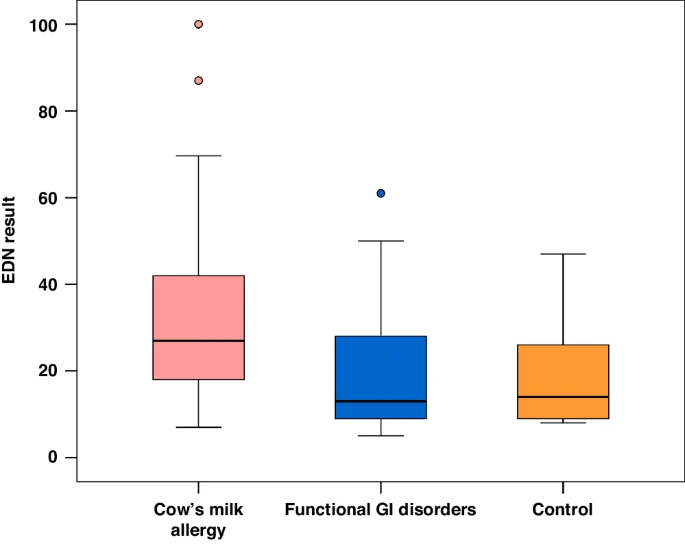Abstract
Background
Cow’s Milk Allergy (CMA) diagnosis is often a challenge due to the non-specific nature of symptoms and lack of a confirmatory diagnostic test. To our knowledge no previous studies investigated serum Eosinophil-Derived Neurotoxin (sEDN) in CMA. So, we aimed to assess the role of sEDN in CMA diagnosis.
Methods
Forty-five infants with CMA were compared to 45 infants with functional gastrointestinal disorders (FGIDs) and 45 healthy controls. For all participants, Cow’s Milk-related Symptom Score (CoMiSS) was documented, and sEDN level with hematological parameters were measured before starting elimination diet.
Results
 |
| Serum Eosinophil-Derived Neurotoxin level among the 3 studied groups. |
Conclusions
sEDN showed high sensitivity in discriminating infants with and without CMA. Therefore, it is suggested as a potential biomarker for CMA diagnosis. Also, ANC should be closely monitored in these infants.
Impact
- CMA presents with high heterogeneity, which complicates the diagnosis especially non-IgE-mediated and mixed types. So, oral food challenge continues to be the gold standard for its diagnosis.
- ROC curve identified CoMiSS > 9 as the best cut-off point to identify CMA. However, CoMiSS is a good awareness tool for CMA but not a diagnostic tool.
- sEDN level was significantly higher in infants with CMA with a good diagnostic performance in differentiating them than those without CMA. So, it is suggested as a potential biomarker for CMA diagnosis.
- ANC could have a role in CMA diagnosis and differentiating it from FGIDs.

No comments:
Post a Comment